The last Condottiere: This class also counting the Guiseppe Garibaldi was built by OTO shipyards in La Spezia, the lead ship being named after Luigi Amedeo, Duke of Abruzzo, Italian explorer and Admiral of the First World War. The Duca degli Abruzzi class cruisers were the final version of the long-standing Condottieri class and were larger and better protected than their predecessors.
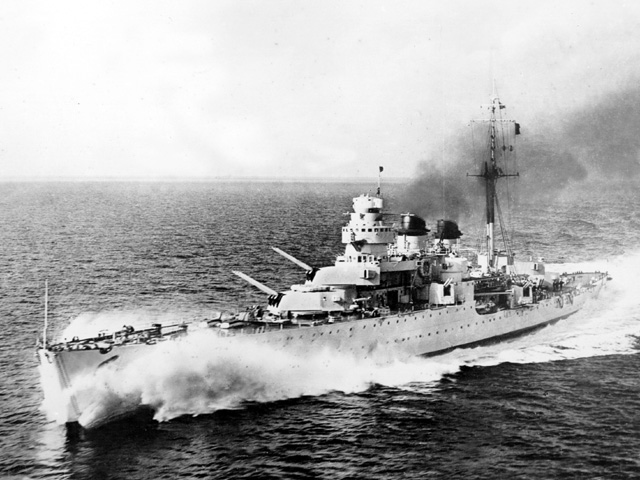
Abruzzi doing her sea trials, 1938
About the Condottieri class
Understanding the “Condotierri” class and its evolution is knowing about Italian cruisers during the last war. Under this generic name roughly meaning “mercenary general”. This is a reference to Renaissance wars in Italy, but the term was kept to describe successful general/statesmen, and indeed this superclass of 10 ships was often named after these historical figures. On paper, they were all light cruisers, aside the heavy cruiser classes, namely the Trento and Zara class.
The first four ships (Guissano) of 1928 were very close to the next pair (Cadorna) in size, armament and tonnage. However, the following three pairs were much larger, jumping from 6000 to nearly 10,000 tons. These were the new generation treaty cruisers, redefined by the treaty of London and putting the emphasis on more light artillery and speed. The Montecuccoli and Aosta were near-sisters, but the last pair, simplified as “Abruzzi” or often named the Garibaldi class, introduced a number of new features.
They appeared in 1937, when the first of the Litorrio new superdreadnought class and the rebuilt Duilio class battleships were introduced to the Regia Marina, equipped with a new generation of secondary armaments. There has been no successor program to the Condottieri, although a sixth group was ordered and studied but none was firmly ordered. This would have been the “Ciano class” (see later).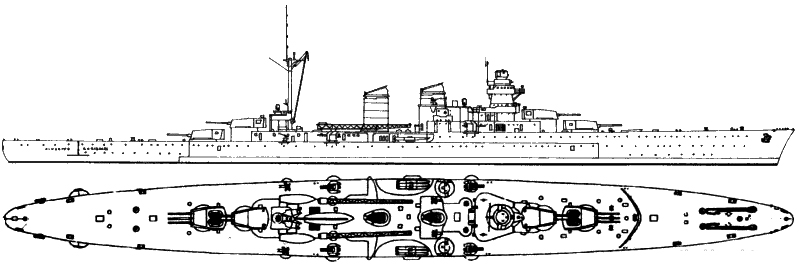 Design of the Abruzzi
Design of the Abruzzi
In short, the two cruisers were slightly larger than the last four ships, and their armament was augmented by two additional 152 mm guns in triple turrets at positions A and Y. The powerplant was also fully revised, allowing greater reliability but at the cost of a slightly lower maximum speed than their predecessors. The first of the two cruisers was completed in 1937, forming the 8th Cruiser Division.
General specifications
Both cruisers displaced slightly more than designed (as customary) at 11,350 tons standard and 11,735 tons fully loaded, to compare with the relatively similar third group Montecuccoli at 7,523 t (7,404 long tons) standard for 8,994 t (8,852 long tons) fully loaded. This was however only 1500 tons more than the fourth group d’Aosta (the displacement of an average destroyer). This increase was explained by the greater beam (1.30 m), additional armor as well as the two additional guns, making larger turrets, wells, and ammunition holds. Dimensions remained the same at least for the length, 171.1 at the waterline and 187 m (561–614 ft) overall, for a beam however of 18.9 m (62 ft) – compared to D’Aosta’s 17.5m (57.7 feets) and a draught of 6.9 m (23 ft), also an increase of about 50 cm.
Installed power and performances
The powerplant was not anemic, with a whopping 100,000 hp (75,000 kW), less however than the 110,000 hp of her predecessor. The two shafts connected to Belluzzo/Parsons geared turbines were fed by six oil-firing Yarrow boilers.
Top speed fell to 34 knots (63 km/h; 39 mph) (62 km/h) compared to 36.5 knots (67.6 km/h; 42.0 mph) on d’Aosta. Range was better however at 4,125 nmi (7,640 km; 4,747 mi) at 13 kn (24 km/h; 15 mph) compared to 3900 nautical miles due to an increase in oil storage also used as an additional buffer for ASW hits.
Armament
That’s by far the most interesting part of the design. For the first time, Italy joined the “triple turrets” club on cruiser design, like UK, France, USA and Japan in the wake of the Treaty of London. One can wonder why the ships did not adopted straight away a four triple scheme like the contemporary Southampton class, but one must remember the prime rival in these waters was France, which developed the Bertin and La Galissonière class with three triple turret, or nine guns. By compromising with twin and triple turret design (the latter been untested yet), the Italians still had the advantage of ten guns while allowing some teething adjustments. However let’s recall that the next class Ciano was still armed the same way.
These 152 mm guns (6-in) were the caliber 55 naval gun Model 1936. They were used also as secondary artillery on the Littorrio class battleships. The 1936 version made by OTO Melara were constructed of two tubes, a loose liner and a horizontal sliding breech block. They fired quick firing separate loading ammunition. Traverse, elevation and other functions were performed electrically. Loading was made by telescopic pneumatic rammers. Loading could be done at +20° while elevations ranged from -5° to +45°. Rate of fire was 4-5 rpm, muzzle velocity 910 m/s (3,000 ft/s) with a 50 kilograms (110 lb) HE or AP shell, with a maximum firing range of 25.7 kilometers (16.0 mi) at +45°.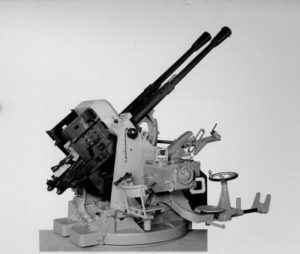
Secondary artillery comprised four twin mounts 8 x 100 mm (4 in) / 47 caliber guns (OTO 1937 100/47). Made by OTO on the model 1928 they were based on the 1910 the WW1 Škoda 10 cm K10 (also used by the Russians since their cruisers were Italian designed). They had a horizontal sliding breech block and an elevation range from -5° to +85°. Rate of fire was 8-10 rpm, firing a 15.2 km (9.4 mi) at 45° with a AA Ceiling of 10 km (33,000 ft) at 80° at a muzzle velocity of 880 meters per second (2,900 ft/s). Tertiary AA armament comprised eight 37 mm (1.5 in) 54-cal. guns and during the war twelve 20 mm (1 in)/65 caliber were added.
The first were Breda classic twin mounts. These automatic, gas operated guns fired a fixed ammunition QF 37 x 232mm SR HE weighting 1.25–1.63 kg (2 lb 12 oz–3 lb 9 oz). Elevation was −10° to +80° for a 60-90-120 rpm at 800 m/s (2,600 ft/s). Effective firing range 4,000 m (4,400 yd) up to 7,800 m (8,500 yd). The 20 mm AA guns were the single gas-operated Breda Model 35, with an elevation of -10 degrees to +80, 240 rpm, firing a 20×138mmB HE shell at 840 m/s (2,800 ft/s). For close quarters, they were two triple banks of 533 mm torpedo tubes. Complement also comprised four Ro.43 planes.
IMAM Ro.43 (1936) based on the Ro37 terrestrial observation aircraft, the standard observation and fighter aircraft of the fleet until 1943, agile but slow. Four were carried, two stored, wings folded in a hangar, two on side catapults each side of the rear funnel.
Protection
The Abruzzi Outer Belt was 30 mm (1.2 in), inner Belt 100 mm (3.9 in). The main Deck protection was 40 mm (1.6 in) down to 10–15 mm (0.39–0.59 in) on the upper deck. The turrets were protected by 135 mm (5.3 in) frontal armor, the barbettes 30 mm up to 100 mm (1.2–3.9 in). The Outer Bulkheads were 30 mm (1.2 in) and behind was an inner layer of 100 mm (3.9 in), whereas the conning Tower protection ranged from 30 mm (roof) to 140 mm (1.2–5.5 in) for the walls.
The sixth group: Ciano class
From 1937 to 1940 there was still a gap allowing the construction of two more groups of cruisers. So why none was produced? The admiralty made a conscious halt after the 5th group, both for budgetary reasons and to study foreign designs, but also because France made a similar pause with the “La Galissonnière” class…
However the main reason was that a specific new type of cruiser was needed to cover operations in the Indian Ocean, to operate from a brand new base at Chisimaio close to the Kenya’s border. On 8 April, 1939 the naval plan asked for three 8000 tons light long range cruisers and many other vessels. The first was to be named in honor of a prominent Fascist party figure deceased, Admiral Costanzo Ciano.
Sources about the ships and exact sketch are still debated. The last design seemed to called for eight 155 mm/55 in quadruple turrets or 9 in triple turrets, at 45° elevation. In November, 1939 eight 90mm/50 in stabilized turrets, were also adopted as well as eight twin 20/65 in stabilized nests. According to Conway’s however, the ships were simply improved versions of the Garibaldi, with the same main, secondary armament, relatively larger size (915 to 11.810 tons FL, 189 m long by 19m), but with the main bridge and superstructure remodelled like the Litorrio class battleships. They would have a thicker deck protection, 115,000 hp for a 33 knots top speed. The second ship would have been named Luigi Rizzo, and later Venezia. However both were suspended in June 1940 while no Yard has been contacted to lay down the keels.
ONI recoignition plate - Garibaldi Class project
Operational career
Duca degli Abruzzi, known for her famous zebra camouflage applied in 1942 participated in the Battle of Calabria, leading the squadron of light cruisers that fired the first salvos of the battle in September 1940. Part of the fleet tried to intercept the British convoys which led to the Battle of Cape Matapan September 24, 1941.
Abruzzi in 1942 with its famous Zebra pattern
The degli Abruzzi was damaged by an aviation torpedo on 22 November 1941, was repaired, but interned by the Allies after the Italian Armistice. She later served in the South Atlantic against operations against potential German raiders. After the war, her torpedo tubes were replaced by two 4-inch anti-aircraft guns. In 1953, she was radically upgraded, equipped with a radar AN/SPS-6 2D aerial on her rear mast.
Following negotiations leading to the handover of Trieste to Italy, the cruiser was transferred from Taranto to Venice, in order to strengthen Italy’s position at the negotiating table. On October 26, 1954, the Duca degli Abruzzi became the flagship of the Italian naval force taking possession of the port facilities of Trieste. She served again in the Marina Militare until 1961.
Garibaldi in May 1942
On her side, Garibaldi was present and fought on 9 July 1940 at the Battle of Calabria with her sister ship, firing the first rounds of the engagement. She managed to hit the British cruiser HMS Neptune, damaging her catapult and reconnaissance aircraft beyond repair. On 1 September, attempted to intercept the Hats convoy. On 29 September, she made another attempt, this time against Operation MB 5, a supply convoy to Malta. On 11 November, she was present at Taranto when the Italian fleet was raided by British airplanes.
On 27 March, Giuseppe Garibaldi she took part in the Battle of Cape Matapan under orders of Captain Stanislao Caraciotti. On 8 May she took part in the force trying to intercept the Tiger convoy. On 28 July she was torpedoed and damaged by the British submarine HMS Upholder but survived and was repaired.
On 3 January, RN Guiseppe Garibaldi escorted the axis convoy M 43. On 7 March, she escorted the large Axis convoy V7 to Libya, teaming with Eugenio di Savoia. On 14 June, she attacked a major British convoy (Operation Vigorous), bound to Malta, which was a success. After the armistice of 8 September 1943, she was found to operate in the South Atlantic against potential German raiders like her sister ship.
After the war, she was modernized with minor changes of the armament and a radar. However, she was decommissioned in 1953 and took in hands for a complete reconstruction as a guided missile cruiser, and served during the cold war, only decommissioned in 1971.
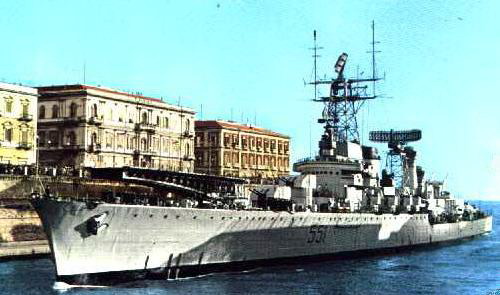
Garibaldi as rebuilt, 1961. This subject is for another day !
Features: (Duca degli Abruzzi, 1940)
Displacement and dimensions: Tonnage 9440 – 11 575 PC, 187 x 18.90 x 6.80m.
Propulsion and performance: 2 turbines with reducers and 8 Yarrow boilers, 2 propellers, 100,000 hp and 34 knots
Protection: Bridges 40 mm, belt 130 mm, turrets 135 mm, blockhouse 100 mm, Crew 692
Armament: 10×152 mm (2×3, 2×2), 8x100mm (4×2), 8×13 mm AA, 8 (2×4) in 1939, up to 12 x 20 mm Breda 1941-43, TLT 533 mm.

Abruzzi in 1939.
Author's HD Profile of the Duca degli Abruzzi in 1942
Author's HD Profile of the Garibaldi in May 1942
Read More/Src:
- Gardiner, John, Conway’s all the world’s fighting ships 1922-1947
- Jordan, John (2008). Warship 2008. Conway Maritime Press
- Smith, Peter Charles (1980). Action imminent: three studies of the naval war in the Mediterranean theatre during 1940. Kimber
- Cunningham, Admiral Sir Andrew B (28 April 1948) memoirs and battle reports.
- About the Garibaldi
- About the Duca degli Abruzzi
- On ww2 cruisers
- https://stefsap.wordpress.com/2015/11/04/the-regia-marina-costanzo-ciano-light-cruisers/


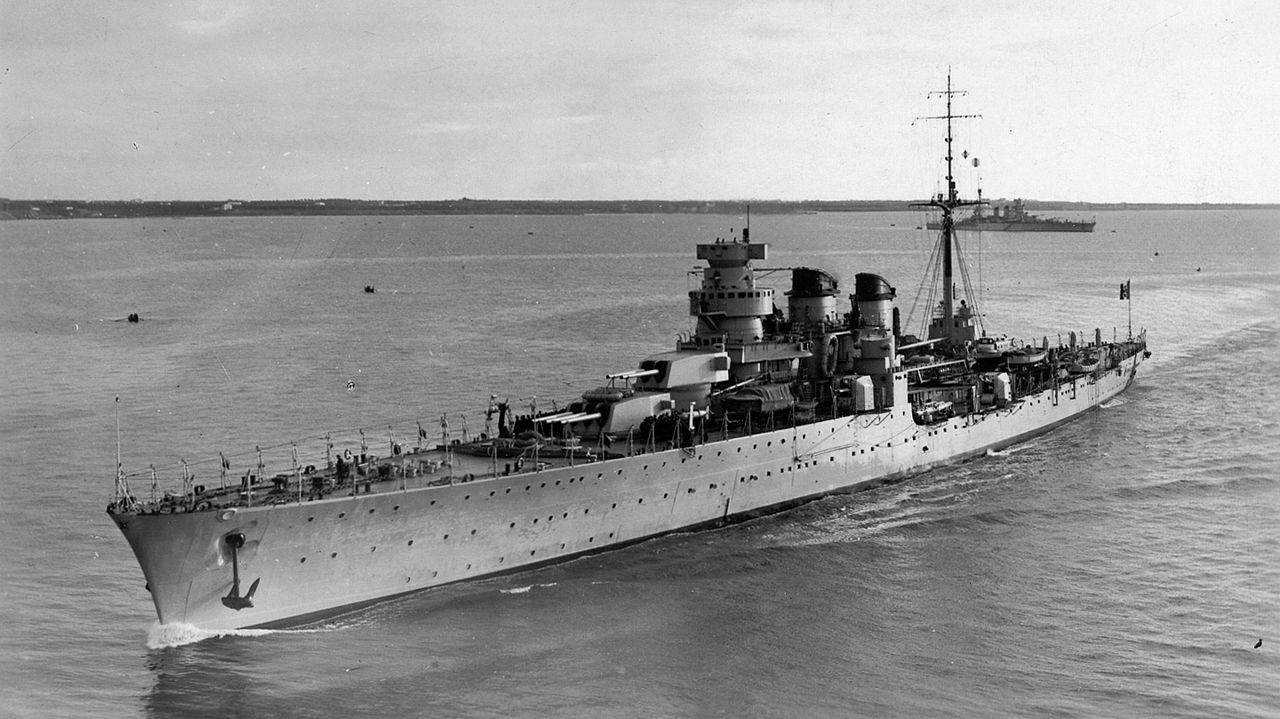

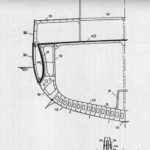
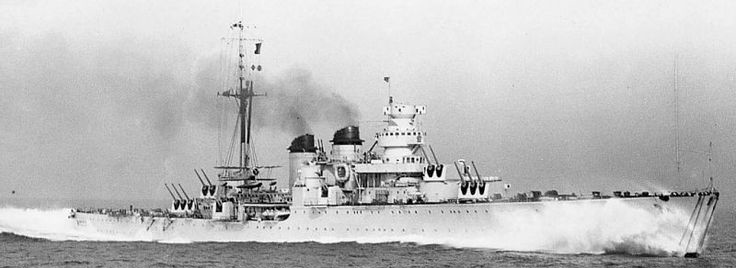
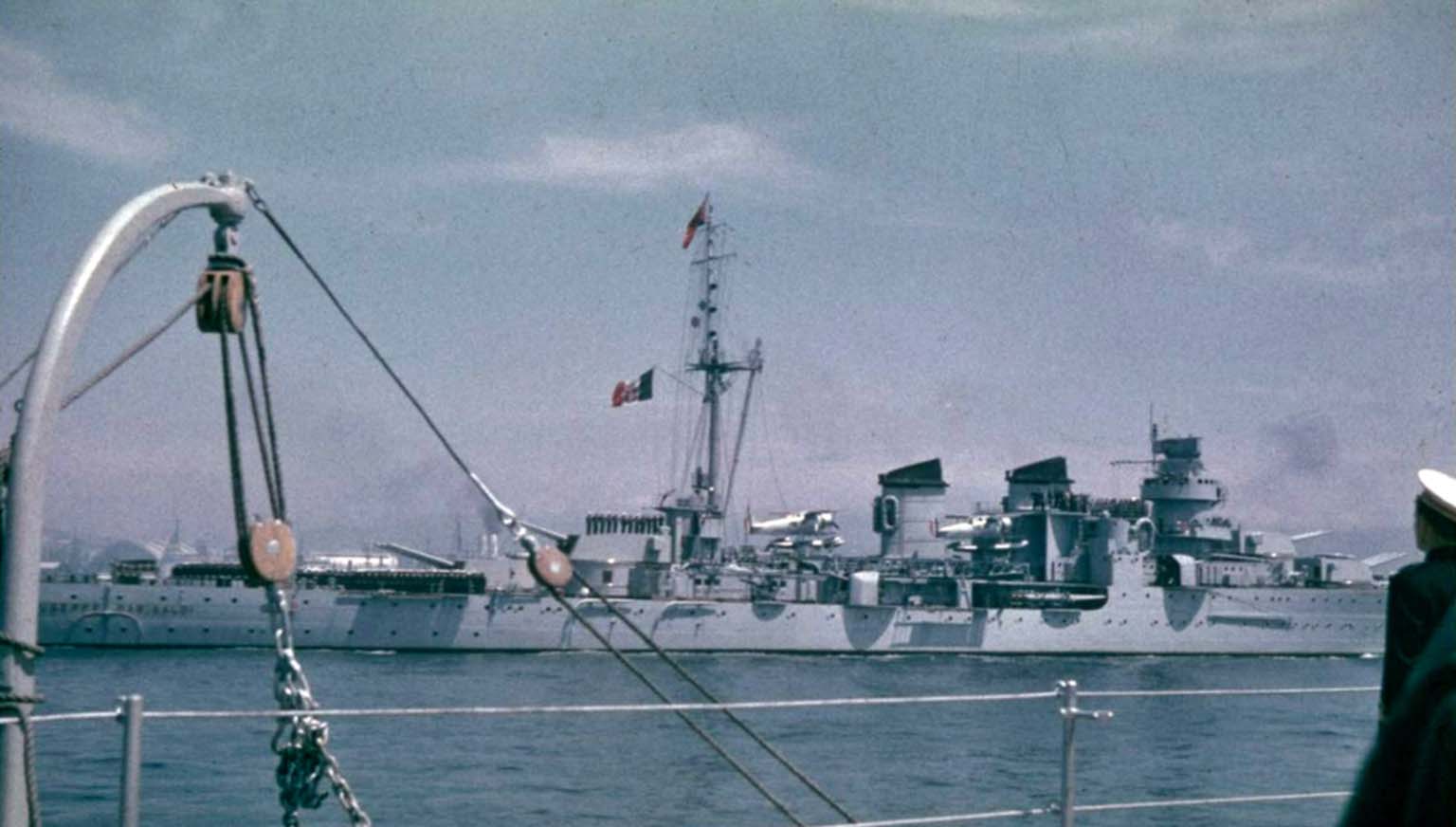
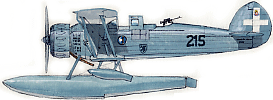
 Latest Facebook Entry -
Latest Facebook Entry -  X(Tweeter) Naval Encyclopedia's deck archive
X(Tweeter) Naval Encyclopedia's deck archive Instagram (@navalencyc)
Instagram (@navalencyc)





 French Navy
French Navy Royal Navy
Royal Navy Russian Navy
Russian Navy Armada Espanola
Armada Espanola Austrian Navy
Austrian Navy K.u.K. Kriegsmarine
K.u.K. Kriegsmarine Dansk Marine
Dansk Marine Nautiko Hellenon
Nautiko Hellenon Koninklije Marine 1870
Koninklije Marine 1870 Marinha do Brasil
Marinha do Brasil Osmanlı Donanması
Osmanlı Donanması Marina Do Peru
Marina Do Peru Marinha do Portugal
Marinha do Portugal Regia Marina 1870
Regia Marina 1870 Nihhon Kaigun 1870
Nihhon Kaigun 1870 Preußische Marine 1870
Preußische Marine 1870 Russkiy Flot 1870
Russkiy Flot 1870 Svenska marinen
Svenska marinen Søværnet
Søværnet Union Navy
Union Navy Confederate Navy
Confederate Navy Armada de Argentina
Armada de Argentina Imperial Chinese Navy
Imperial Chinese Navy Marinha do Portugal
Marinha do Portugal Mexico
Mexico Kaiserliche Marine
Kaiserliche Marine 1898 US Navy
1898 US Navy Sovietskiy Flot
Sovietskiy Flot Royal Canadian Navy
Royal Canadian Navy Royal Australian Navy
Royal Australian Navy RNZN Fleet
RNZN Fleet Chinese Navy 1937
Chinese Navy 1937 Kriegsmarine
Kriegsmarine Chilean Navy
Chilean Navy Danish Navy
Danish Navy Finnish Navy
Finnish Navy Hellenic Navy
Hellenic Navy Polish Navy
Polish Navy Romanian Navy
Romanian Navy Turkish Navy
Turkish Navy Royal Yugoslav Navy
Royal Yugoslav Navy Royal Thai Navy
Royal Thai Navy Minor Navies
Minor Navies Albania
Albania Austria
Austria Belgium
Belgium Columbia
Columbia Costa Rica
Costa Rica Cuba
Cuba Czechoslovakia
Czechoslovakia Dominican Republic
Dominican Republic Haiti
Haiti Hungary
Hungary Honduras
Honduras Estonia
Estonia Iceland
Iceland Eire
Eire Equador
Equador Iran
Iran Iraq
Iraq Latvia
Latvia Liberia
Liberia Lithuania
Lithuania Mandchukuo
Mandchukuo Morocco
Morocco Nicaragua
Nicaragua Persia
Persia San Salvador
San Salvador Sarawak
Sarawak Uruguay
Uruguay Venezuela
Venezuela Zanzibar
Zanzibar Warsaw Pact Navies
Warsaw Pact Navies Bulgaria
Bulgaria Hungary
Hungary

 Bundesmarine
Bundesmarine Dutch Navy
Dutch Navy Hellenic Navy
Hellenic Navy Marina Militare
Marina Militare Yugoslav Navy
Yugoslav Navy Chinese Navy
Chinese Navy Indian Navy
Indian Navy Indonesian Navy
Indonesian Navy JMSDF
JMSDF North Korean Navy
North Korean Navy Pakistani Navy
Pakistani Navy Philippines Navy
Philippines Navy ROKN
ROKN Rep. of Singapore Navy
Rep. of Singapore Navy Taiwanese Navy
Taiwanese Navy IDF Navy
IDF Navy Saudi Navy
Saudi Navy Royal New Zealand Navy
Royal New Zealand Navy Egyptian Navy
Egyptian Navy South African Navy
South African Navy






























 Ukrainian Navy
Ukrainian Navy dbodesign
dbodesign